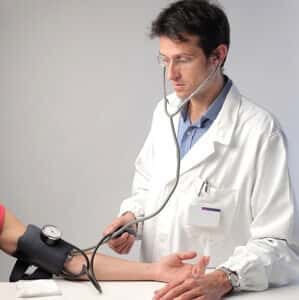
The opening ritual for almost every doctor visit involves measuring weight and blood pressure. For such fundamental data, there is a surprising lack of attention to accuracy.
There are often no standardized rules about whether or not to keep your shoes on when you step on the scale. People who weigh themselves at home know that getting naked makes a difference in what the scale says. Clothes, wallet, keys, watch and smart phone can add a couple of pounds.
Even more critical is blood pressure evaluation, as it can have a profound impact on diagnosis and treatment. Once labeled hypertensive, a person may have to take medication indefinitely.
Measuring blood pressure correctly is not as easy as it looks. Some people get anxious about visiting a doctor’s office and experience blood pressure elevation just walking in the door. This “white coat” hypertension is surprisingly common. One study found it affects over 20 percent of the volunteers tested (JAMA, Jan. 8, 1988). If you suspect you’re among those with white coat hypertension, you’ll want to measure your blood pressure at home.
Whether at home or in the doctor’s office, sit in a comfortable chair with a back and both feet on the floor with the arm supported at the level of the heart. It is crucial to use a cuff of the proper size and remain silent during the measurement.
One reader tells the following story:
“My pressure has always been normal or below normal. When I go to the doctor, it is higher than at home. My doctor says I have white coat hypertension because I get nervous.
“I disagreed about that because the medical assistant took my blood pressure while I was seated on the edge of the exam table with no support for my back or my arm. My feet were dangling as she put the cuff on (over my blouse). I asked if I could be seated on the chair with my feet on the floor and was told that the cord wouldn’t reach that far.
“By that time, I was so frustrated I’m sure my pressure would have been high no matter how it was taken. When my doctor came in and saw the readings, she wanted me to consider medication. When I objected and told her what happened, she more or less tuned me out.
“My husband is being treated for hypertension with lots of meds. I wonder if he needs all of them. His pressure was taken the same way—feet dangling, arm unsupported, slouching on an exam table.
“I just wonder if his blood pressure is as bad as they think it is. He measures it at home and the pressure is usually 15 to 20 points lower.”
This reader’s concerns are valid. The American Heart Association has made recommendations on blood pressure measurement that were largely ignored in the encounters she described (Circulation, Feb 8, 2005).
We provide details on accurate home measurement and non-drug approaches to controlling blood pressure, as well as pros and cons of antihypertensive medicines, in our Guide to Blood Pressure Treatment.

